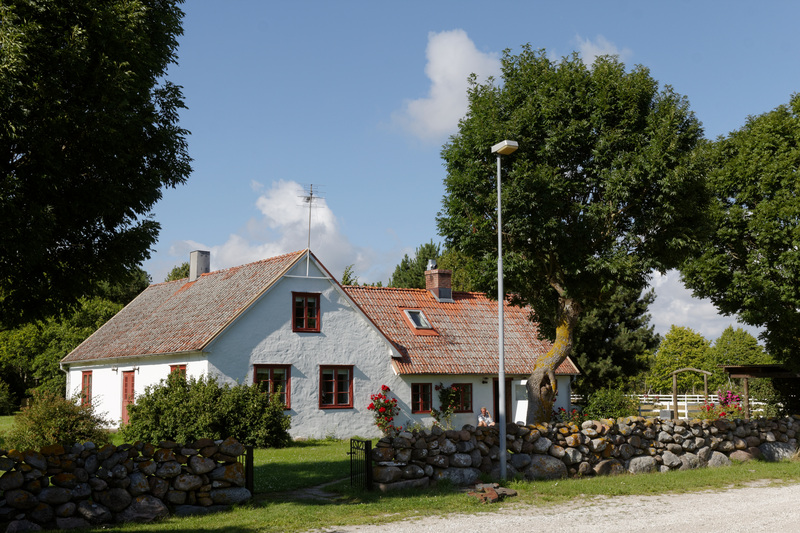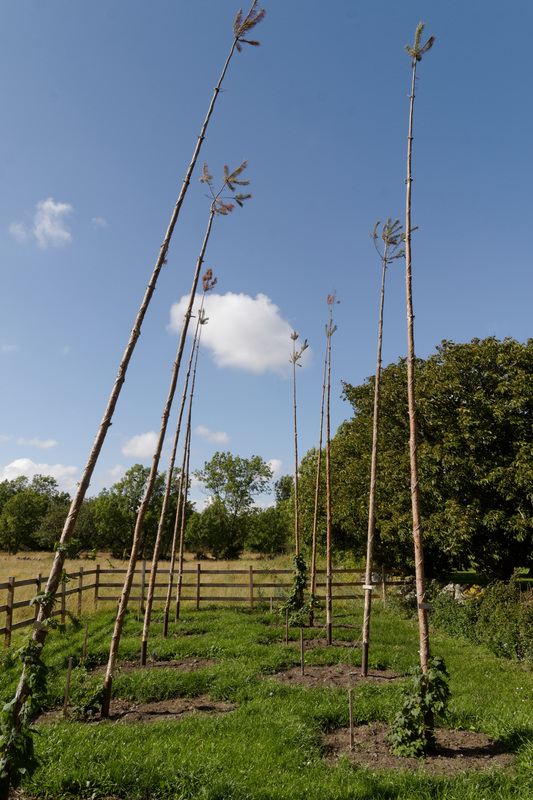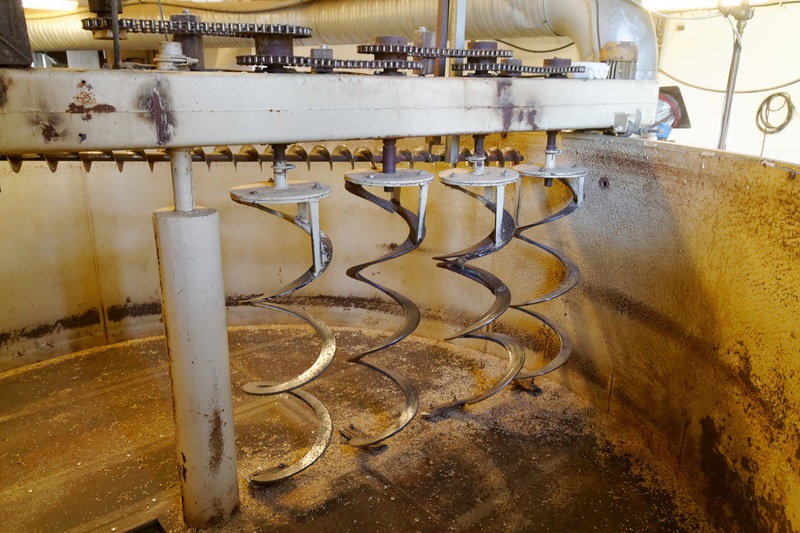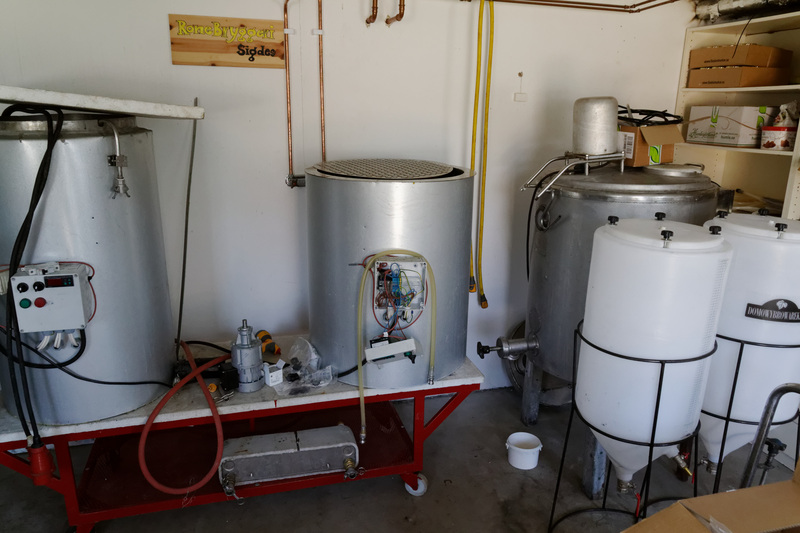A maltster on Gotland

The house |
While on holiday on Gotland I saw a note on a poster about an open farm and something about malt being made. There was a phone number, so I decided to call. Yes, the voice at the other end said, he made malts, but not the traditional way. His neighbour did, however. Sure, I could come visit, and if his neighbour was home we could see his malt house.
I drive up in front of the house and stop. No sign of life. I walk up to the front door and ring the doorbell. The door opens immediately, and I'm invited into the kitchen, where Staffan is eating strawberries with milk. I join him, as we chat about malting and brewing. Then, the moment I'm finished, he jumps up, clears away the bowls, and off we go.
He starts off by showing me his hop garden, which he's just planted. Then we go into his brewery in the barn. It looks very modern, with steel tanks, electronics, and plastic fermenters. "You want a sip," Staffan asks. Sure, why not. It's a clearish, amber beer. The taste is bone dry, powerfully citric and resiny, quite fizzy. Very craft, not even remotely farmhouse.

Hop garden |
So I ask him a bit about his brewing. It turns out he distinguishes between "beer" (modern beer) and "dricke" (gotlandsdricke), and he brews beer. The reason is he just doesn't like gotlandsdricke. He doesn't say, but having encountered this before my guess is he's one of those people who loathe sweetness, which is obviously going to be a showstopper. Plus, he says, he doesn't like the smoke flavour.
He asks if I want to see his malt making. "Sure," I say. We go into the next room, dominated by a big yellow vat with some complicated machinery on top. Looking at it I quickly realize this is a malting machine. A pipe leads hot air in underneath the vat, and there are Archimedes screws for turning the malts. The screws sit on a metal beam that rotates around the side of the vat.

The malt machine |
"Where did you buy this? It must have been really expensive," I
say.
"I didn't buy it. I made it."
"You made it?"
"Yes. This is the fourth machine."
"What do you mean, the fourth? Where are the other three?"
"This is the fourth attempt. It took this many tries to get it
really good."
"You mean you invented the whole thing?" I'm getting
pretty incredulous at this point.
"Yes. I had some help from a smith and an electrician, though."
It turns out that when Staffan gave up on being a pig farmer someone asked him if he could make malts for a local whisky distillery. He decided to try, but the malts didn't come out well. So he studied all the literature he could find, and started making these machines.
He must be reading the amazement in my face, because he says defensively that "I was a pig farmer for 30 years, so I've been tinkering with screws and that kind of thing all my life." And thinking about it I can see what he means. I've met a few farmers now, and they're all extremely practical people, forever tinkering with machines and constructing all kinds of things. So yes. But I'm still impressed.

Archimedes screws |
There are people in both Denmark and Norway trying to start producing malts, and while some have succeeded they've all found it pretty hard. And yet this guy hasn't just succeeded in making malts, he's even invented a malting machine!
I ask him to explain how it works. It turns out that he steeps the grains in the machine, running off and replacing the water at intervals. Then he does the germination, also in the machine, using the screws to keep the sprouting even and prevent the malt from caking. Finally, he dries it in the machine. He burns peat or wood pellets for the drying, depending on whether he's producing smoked malts or not.
"This way, I don't have to move the malts at all," Staffan says, clearly pleased. Indeed. His design is obviously derived from the Saladin box, but that's only used for germination. With this thing Staffan has extended the machine to cover the entire malting process, doing away with lots of heavy manual work. You add grain to the machine, and later you take out malts. Done.

Heater for the malt machine |
The machine has a capacity of 2 tons a week. He doesn't say, but I assume that since it's so highly automated that probably means he could produce some 40-50 batches a year, all by himself. He grows the barley himself, and says the variety is Tippla. The malts are dried at 60C, so it's a pale malt.
He explains that he's actually sold the machine to several other producers on the mainland. He wanted to just send them some drawings "and they could build it themselves, but they didn't want to." Well, no surprise there. Not everyone thinks building a machine this size is something you just do. So eventually Staffan built the machines for them.
As we leave the barn he explains that he's thinking of beginning to sell beer commercially in local inns. I ask him if he's going to sell gotlandsdricke. "You can't sell that," he says. I never manage to get an explanation of why not, but I see from Untappd that he's now selling his beer at Kapten Grogg, at least.

The brewery |
I ask a bit about his traditionally malting neighbour, but he turns out not to be home, so we can't see the malt house. The neighbour makes traditional malts and beer, and he also sells traditional malts to other brewers. The malts are smoked with birch wood.
I ask Staffan if his neighbour boils the wort. "Of course he boils the wort! It won't become beer otherwise," he barks. I tell him that Anders, a 10-minute drive away, doesn't boil the wort at all, and he just looks at me expressionlessly. I decide not to push the point.
Eventually, my time is up, and I drive off back to Visby.

Farmhouse by the road, Värsände |
Similar posts
Svein, maltster and brewer
At first glance it looked like any house in the area, a two-storey wooden house
Read | 2017-03-19 11:17
Gotlandsdricke - an overview
A lot has been written on Gotlandsdricka, but the writers generally call it "an ancient beer" or "indigenous beer" and variations on that theme
Read | 2017-01-08 13:24
Hegra maltøl at Granås Gård
Our final stop on the trip was actually the first to be planned
Read | 2014-09-09 17:20
Comments
Dan Pixley - 2017-01-10 13:55:55
That last exchange about the boiling of the wort was almost comedic!
Eike - 2017-01-17 13:27:47
Any chance you have an email address for the guy or a copy of his plans for the machine? Would be fasinating to try to build a version.
Courtlyn - 2017-05-05 21:38:14
Same question as Eike. Any chance you still have contact info for Staffan. I would love to take a look at the plan for his design. Thanks for all the great info on your Blog, i have thouroughly enjoyed reading about many of your explorations.
Cheers,
Courtlyn Puerto Montt Chile
Lars Marius Garshol - 2017-05-06 09:27:56
I'm afraid I don't have his contact details. Usually I take care to note address and phone number, but for some reason I failed to this time. I don't know why. However, I did a search now, and I'm pretty sure it's this guy: https://personer.eniro.se/p/staffan+larsson/1731074
Courtlyn. - 2017-05-12 17:34:20
Thanks Lars. Really loving your blog. Keep it up! We brew 250 liter batches here in southern Chile and on account of propane prices boil the hops in a separate container. The min batch is usually only boiled for 5 to 10 minutes so i guess it's not really raw ale. Do you know how the kviek was cultured years and years ago? Something like catching sour dough bread yeaat? What i find interesting is many of the kveik strains mentioned on the blog most of them are not sour. Anyway thanks again. Bestregards from apatagonia, Courtlyn
Moss - 2018-01-30 00:58:10
Wow this is so cool!
Did anyone manage to make contact and see any plans? Would love to make something like this myself
Julie Tunseth - 2018-02-14 17:13:12
Thanks for the great article. I would love to get contact information on Staffan at Gotland.
Lars Marius Garshol - 2018-02-14 19:33:44
Here are Staffan's contact details. That page lists him twice, for some reason, but I'm pretty sure both entries are him.
Alex - 2020-04-30 22:13:40
A great piece Lars, thank you for sharing. I too am interested in his design. I don't suppose you have any more photos?
Lars Marius Garshol - 2020-05-01 08:10:21
@Alex: Sorry, no. I guess you'll have to contact him directly. See the comment above yours.
Nick Trausch - 2020-05-02 22:01:05
Thanks Lars for the neat story about malting. I was delighted to see the hop garden also. I'm thinking of doing something similar here in Mingo Junction, OH USA, only using PVC pipes.